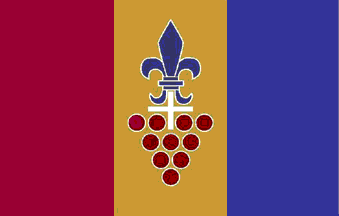 image by Bruce Berry, 14 Dec 2006
image by Bruce Berry, 14 Dec 2006
Last modified: 2019-08-06 by bruce berry
Keywords: stellenbosch | cape town |
Links: FOTW homepage |
search |
disclaimer and copyright |
write us |
mirrors
 image by Bruce Berry, 14 Dec 2006
image by Bruce Berry, 14 Dec 2006
The new municipality of Stellenbosch in the Western Cape Province of South Africa is an amalgamation of the former towns of Stellenbosch, Franschhoek and Pniel following the reorganisation of local government in South Africa on 05 December 2000. Stellenbosch is the second oldest European settlement in South Africa after Cape Town, and is situated about 50 kilometers from Cape Town along the banks of the Eerste River. The town was founded in 1679 by the then Governor of the Cape Colony, Simon van der Stel, who named it after himself — Stellenbosch means "(van der) Stel's forest". It is situated on the banks of the Eerste River ("First River"), so named as it was the first new river he reached and followed when Jan van Riebeeck sent him from Cape Town on an expedition over the Cape Flats to explore the territory towards what is now known as Stellenbosch. The town later became known as the City of Oaks or "Eikestad" in Afrikaans due to the large number of Oak trees that were planted by the founder to grace the streets and homesteads.
Soon after the first settlers arrived, especially the French Huguenots, grapes were planted in the fertile valleys around Stellenbosch and it soon became the centre of the South African wine industry. The first school had been opened in 1683 but education in the town began in earnest in 1859 with the opening of a seminary for the Dutch Reformed Church. The town remains a major educational centre with the University of Stellenbosch opening in 1863. Although principally an Afrikaans language institution, many courses (especially post-graduate) are now offered in English.
The enlarged Stellenbosch Municipality is unusual in that the municipal symbols used by the towns from the previous local government dispensation which now fall under its jurisdiction may still continue to be used unofficially.
The new municipal flag consists of three equal vertical stripes of burgundy, gold and royal blue. These colours are taken from the municipal arms which are depicted in the central stripe, with the usual gold trimmings in white.
wc-st.jpg) scan by Bruce Berry, 14 Dec 2006
scan by Bruce Berry, 14 Dec 2006
The new municipal coat of arms is a configuration of three symbols chosen from the three towns of Stellenbosch, Franschhoek and Pniel namely the grapes, Fleur-de lis and cross. It is combined to form a new symbol, symbolising the joining of the three towns into one municipality without losing the individuality of the original elements. The new symbol reminds one of a burning flame, a symbol of hope and energy.
The grapes, in burgundy, edged by a golden line, represents Stellenbosch which is world famous for grapes and wine. The Fleur-de lis in royal blue, edged by a golden line, represents Franschhoek, showing the strong affiliation to the French Fleur-de lis. The golden cross represents Pniel, which started out as a missionary establishment when the church still represented the centre of the community.
wc-st1.jpg) scan
by Bruce Berry, 14 Dec 2006
scan
by Bruce Berry, 14 Dec 2006
The new Arms replace those originally granted under Letters Patent dated 26 June 1952 by the College of Arms. These were subsequently registered with the South African Bureau of Heraldry on 31 August 1979 with the following blazon:
Arms: Or, on a fess, between three
towers Gules, a peacock in his pride proper between two annulets
Or.
Crest: An anchor Or entwined
with a branch of oak, leaved and fructed proper.
Wreath and Mantling: Or and Gules
Motto: FORTIS ET SUPERBUS
In terms of a municipal by-law
pertaining to Corporate Identity, the colours of the new flag and arms are
stipulated as being red (Pantone 202), blue (Pantone 2747) and gold (Pantone
1255). Unauthorised and/or improper use of the flag is subject to a fine of ZAR5 000.
Bruce Berry, 14 Dec 2006
A small correction to Bruce Berry's note about the University of Stellenbosch: this came into existence in 1918, incorporating Victoria College. The college began teaching in 1866. For more information, see http://www.geocities.com/bona_spes/VicCollE.html.
In 1918 three separate Acts of Parliament came into
force creating the University of Stellenbosch (out of Victoria College), the
University of
Cape Town (out of the South African College) and the University of South Africa
(previously the University of the Cape of Good Hope).
Mike Oettle, 15 Dec 2006